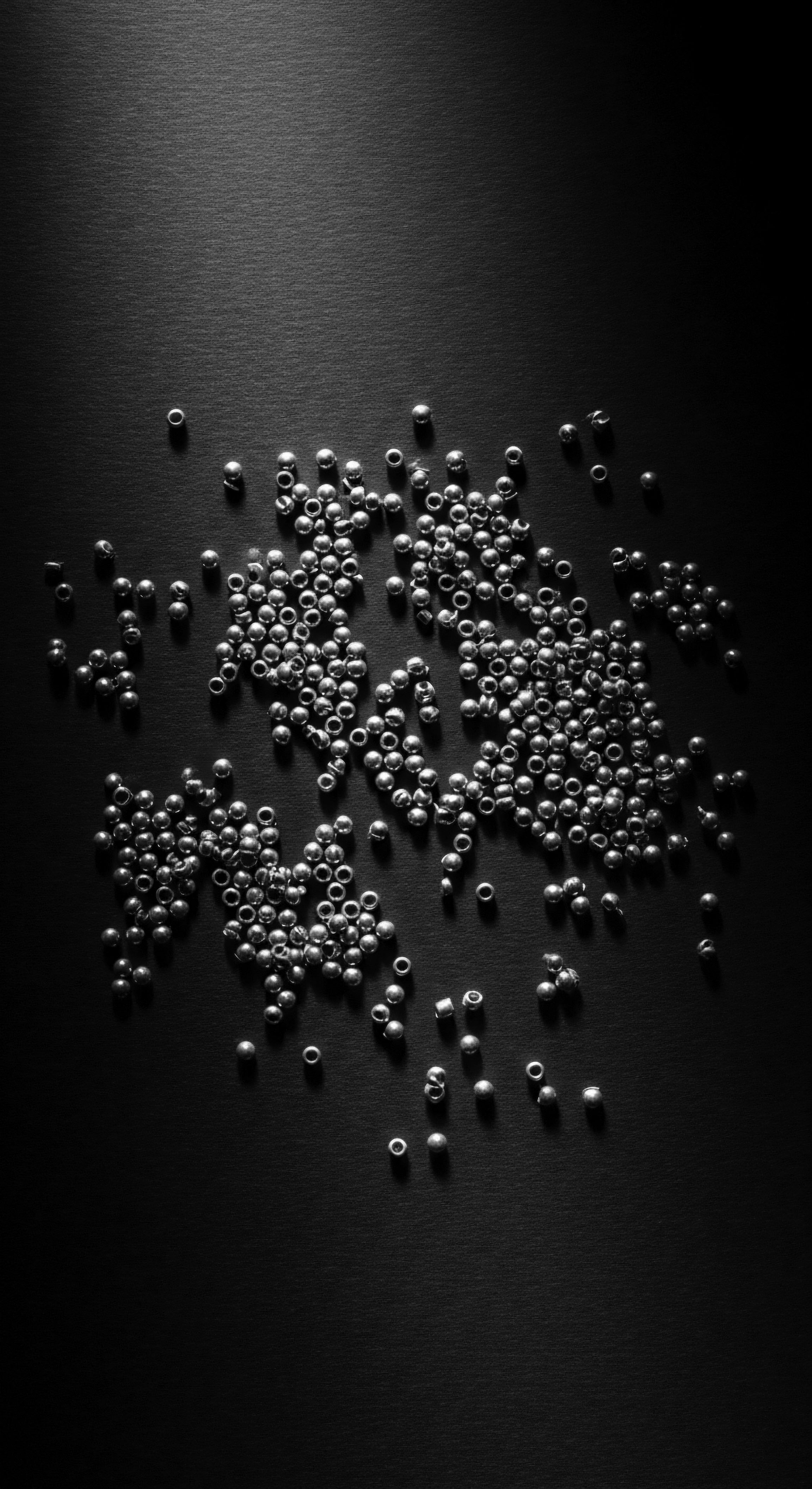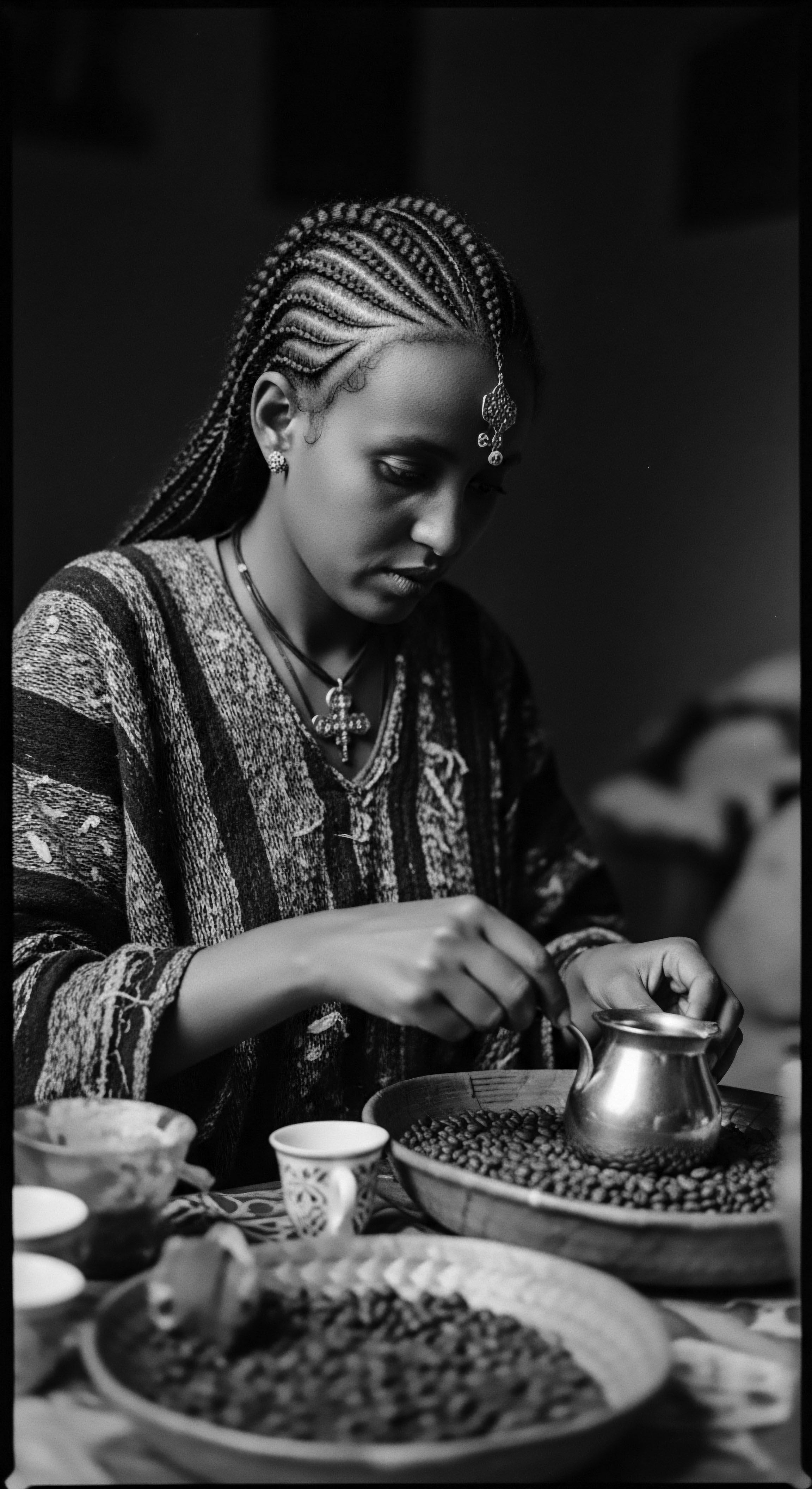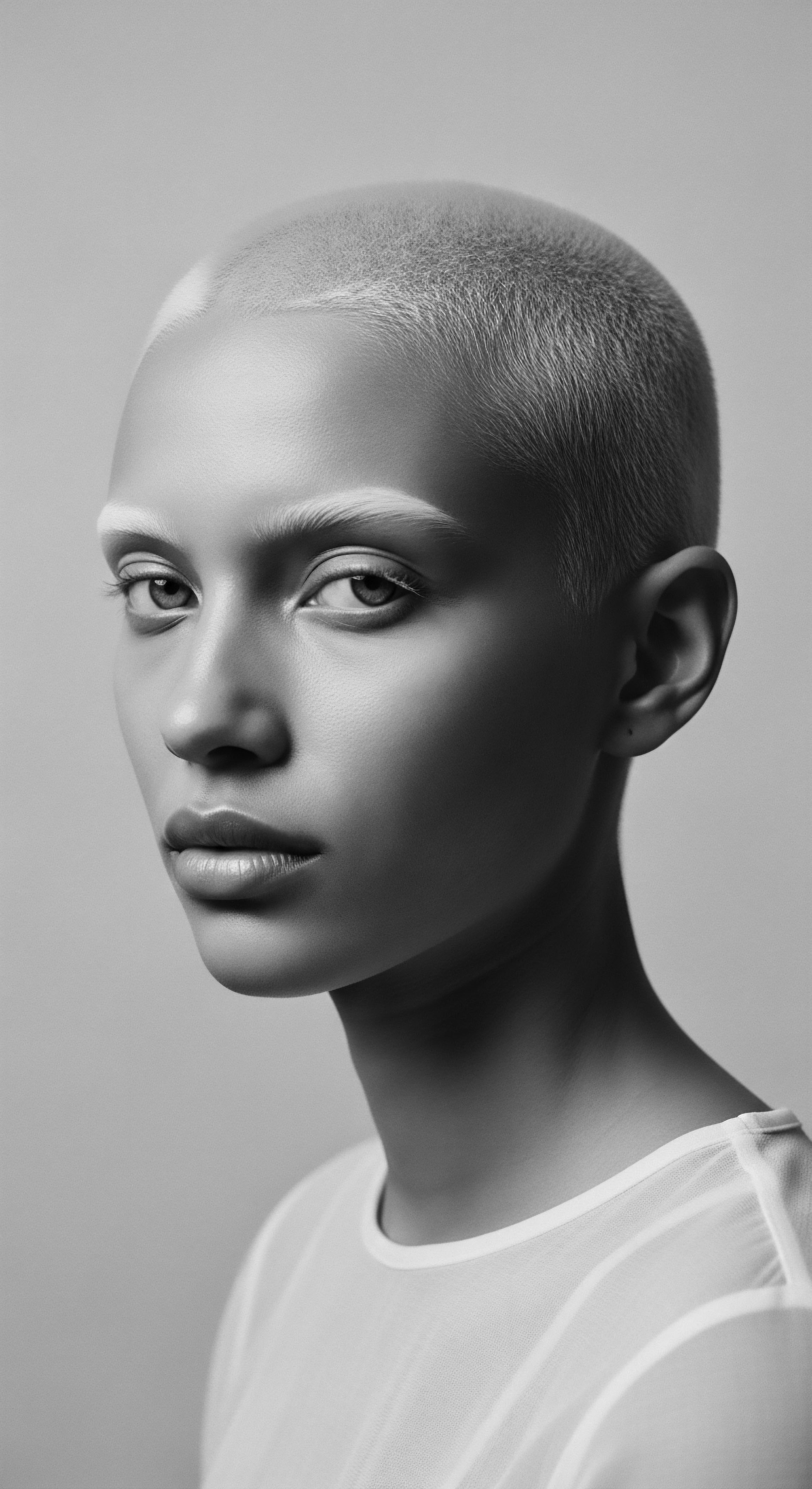
Roots
When the moon ascends, casting its soft glow upon the world, and the rhythmic cadence of the day gives way to the stillness of night, a quiet, profound ritual often takes hold within homes where textured hair lives. For countless individuals across generations, particularly those whose ancestral lineages wind through the rich soils of Africa and its diaspora, the drawing on of a silk bonnet before slumber is more than a simple act of hair care. It is, perhaps, a whisper carried on the wind from distant shores, a tangible connection to practices steeped in the very Heritage of textured hair. This simple garment, silken and smooth, holds within its delicate fibers a story – a continuous narrative woven from resilience, self-preservation, and an abiding respect for the intrinsic qualities of coily, kinky, and wavy strands.
The understanding of textured hair, from its elemental biology to the nomenclature we employ to describe it, is not merely a modern scientific endeavor. It is a journey backward in time, tracing pathways of knowledge passed down through oral traditions, observation, and lived experience. Ancient civilizations, long before the advent of microscopes, possessed an intuitive grasp of how to protect and sustain these crowning glories.
The unique helical structure of textured hair, prone to dryness and breakage due to its natural curvature and raised cuticle, presented challenges that generations thoughtfully addressed. This inherent quality, so beautiful in its form, also requires a distinct approach to its preservation, a reality known by our forebears.

Hair’s Intrinsic Architecture
At its very fundamental level, each strand of textured hair embodies a complex anatomical design. Unlike straight hair, which typically grows in a circular or oval cross-section, textured hair often exhibits an elliptical or even flattened cross-section. This shape contributes to its characteristic curl pattern and also means that the hair shaft does not lie flat against the scalp, making it more difficult for natural oils to travel down the entire length of the strand.
The outermost layer, the cuticle, which functions as the hair’s protective shield, tends to be more raised and fragmented in textured hair, which, while aiding in volume, also exposes the inner cortex to environmental elements. This structural reality, a biological signature of our Ancestral Hair, demands vigilant care to maintain its integrity.
The protective embrace of a silk bonnet echoes generations of wisdom dedicated to nurturing the unique form of textured hair.
The ancestral wisdom around hair care implicitly understood these vulnerabilities, even without contemporary scientific terminology. Practices focused on hydration, gentle handling, and protective measures were paramount. The silk bonnet, while a relatively modern iteration in its widespread form, is a spiritual successor to various historical methods employed to safeguard hair during rest.
Think of the head wraps and coverings worn by women in West African societies, not solely for adornment or cultural identity, but also for practical purposes – to protect hair from dust, sun, and the friction of daily life, including sleep. The continuity of these protective principles forms a significant part of textured hair Heritage.

Historical Dimensions of Hair Protection
Delving into the history of hair care reveals a rich tapestry of practices designed to maintain health and aesthetic appeal. Before the widespread availability of textiles like silk, other natural materials would have been employed. Bark cloths, finely woven plant fibers, or even animal hides softened and prepared, could have served similar protective roles.
The very idea of covering the hair at night, or when not actively styling, speaks to a deep, inherent understanding of its delicate nature and the need to shield it. This tradition transcends geography, appearing in various forms across continents where populations with textured hair resided.
The advent of trade routes brought new materials, and silk, with its smooth surface and minimal absorption, would have been recognized for its superior protective qualities. The transition from more rustic coverings to the refined silk bonnet speaks to an evolving material culture while the underlying protective principle remained constant. This evolution is a testament to the ingenuity and resourcefulness inherent within diasporic communities, consistently seeking the best means to care for their hair, preserving its vitality and its connection to their Lineage.
| Historical Period Ancient Africa (Pre-15th Century) |
| Traditional Practices Early understanding of protection from elements and friction. Demonstrated resourcefulness and knowledge of hair's needs. |
| Historical Period Post-Transatlantic Slave Trade (17th-19th Centuries) |
| Traditional Practices Resilience in maintaining hair care despite oppressive laws; head coverings became symbols of defiance and cultural preservation. |
| Historical Period Early 20th Century (Great Migration Era) |
| Traditional Practices Adapting traditional practices to new environments; continued emphasis on moisture retention and physical protection. |
| Historical Period The journey of hair coverings for textured hair reflects both necessity and persistent devotion to hair health and identity. |

Ritual
The act of donning a silk bonnet transcends mere habit; it embodies a ritual, a mindful acknowledgment of the preciousness of one’s hair and the long legacy of care that surrounds it. This is a practice deeply ingrained within the routines of those with textured hair, transforming a simple bedtime preparation into a moment of connection with a broader Heritage. The smooth, cool touch of silk against delicate strands is a soothing gesture, a silent promise of protection through the night. This daily ritual, repeated across homes and continents, underscores the ongoing journey of nurturing hair that carries the whispers of generations.

Styling Preservation Through The Night
Protective styles, a cornerstone of textured hair care, have deep ancestral roots. Braids, twists, and coils were not only expressions of artistry and status in many African societies but also served practical functions ❉ minimizing manipulation, retaining moisture, and safeguarding hair from environmental damage. The silk bonnet extends this protection into the hours of sleep, preventing the friction and moisture loss that ordinary cotton pillowcases can inflict. The very act of preserving a protective style with a bonnet links contemporary practice to the long-standing tradition of minimizing damage and promoting healthy growth – a core tenet of our hair Heritage.
Consider the meticulous care involved in creating intricate styles such as cornrows or Bantu knots. These styles, often taking hours to execute, represent a significant investment of time and skill. To wake with these styles disturbed, frizzy, or damaged by friction is not only frustrating but counterproductive to hair health. The silk bonnet acts as a shield, a guardian, preserving the structural integrity of these styles.
This preservation, in turn, allows for longer wear, reducing the frequency of manipulation and promoting length retention. This practical application directly honors the historical value placed on hair length and health within many Black and mixed-race communities.
The nightly bonnet ritual stands as a quiet yet powerful act of defiance against hair fragility, a legacy of wisdom passed down.
The use of silk, specifically, for bonnets is a refined evolution. While natural fibers were used in earlier times, silk’s unique properties – its smooth surface and low absorbency – make it particularly beneficial for textured hair. Unlike cotton, which can draw moisture from the hair and create friction, silk allows the hair to glide, minimizing tangles, breakage, and frizz. This selection of material speaks to an informed, intuitive understanding of hair needs, a knowledge refined over generations through trial and observation, eventually favoring materials that offer optimal defense.

Care Across the Diaspora
The spread of textured hair traditions across the diaspora saw adaptations and continuities. In the Americas, especially during and after enslavement, hair became a powerful symbol of identity, resistance, and often, a site of vulnerability. Hair care practices, sometimes clandestine, became acts of self-preservation and cultural transmission.
The necessity of protecting hair from harsh conditions and forced labor contributed to the development of robust care regimens, including nighttime coverings. This period underscored the critical role of protective measures in maintaining not only physical hair health but also a spiritual connection to one’s roots.
- African American Traditions ❉ The practice of wrapping hair at night, predating modern silk bonnets, was a common strategy to protect hair from tangles and to preserve moisture, adapting ancestral knowledge to new circumstances.
- Caribbean Hair Practices ❉ Similar to African American customs, the use of scarves and head coverings for night protection helped maintain styles and prevent dryness, particularly in humid climates.
- European Mixed-Race Heritage ❉ Individuals with mixed heritage often adopted these protective measures as they navigated different hair textures within their families, seeking to prevent damage and maintain a smooth appearance.
The choice of a silk bonnet today represents a conscious continuation of these historical practices. It is a decision rooted in knowledge passed down, sometimes explicitly, sometimes subtly, through generations of mothers, grandmothers, and community elders. This continuity strengthens the cultural thread that binds past to present, transforming a simple accessory into a symbol of enduring care and cultural pride. It acknowledges that the journey of textured hair is not merely individual but communal, a shared experience spanning centuries.

Relay
The silk bonnet’s role in honoring textured hair heritage extends to its significant contribution to the overall health and vitality of the hair strand itself. This is where ancestral wisdom meets contemporary understanding, where long-held practices find their validation in scientific principles. The nightly ritual with a bonnet contributes significantly to moisture retention and friction reduction, two critical factors for maintaining the structural integrity of textured hair, which by its nature, is more prone to dryness and breakage. The relay of knowledge from our ancestors, often gleaned through empirical observation, directly informs these modern applications, reinforcing the deep wisdom embedded in our hair Lineage.

Moisture Preservation and Friction Reduction
Textured hair, with its unique structural properties, faces challenges in retaining moisture. The natural oils produced by the scalp, sebum, often struggle to travel down the coiled or curled hair shaft, leaving the ends particularly vulnerable to dryness. Cotton pillowcases, ubiquitous in many homes, possess an absorbent quality, acting like tiny sponges that draw moisture from the hair as one sleeps. This continuous stripping of hydration can lead to parched strands, increased frizz, and ultimately, breakage.
Silk, conversely, is a smooth, non-absorbent protein fiber. Its surface allows hair to glide freely across it, virtually eliminating the friction that causes tangles, snags, and mechanical damage. This reduction in friction is particularly critical for textured hair, as its delicate curl patterns can easily become disrupted and stressed by abrasive surfaces. By minimizing moisture loss and friction, silk bonnets act as a nightly guardian, preserving the hair’s natural hydration and protecting its delicate structure, a practical manifestation of care passed through generations.

Addressing Historical Hair Trauma
For centuries, textured hair has been subjected to various forms of marginalization and abuse, both societal and physical. From the forced shaving of heads during enslavement to the stigmatization of natural textures in professional and social settings, the historical context of Black and mixed-race hair is often one of struggle and resilience. The continuous need to conform to Eurocentric beauty standards often led to harsh chemical treatments and excessive heat styling, causing significant damage.
In this light, the silk bonnet becomes more than a protective accessory; it transforms into a symbol of healing and reclamation. It represents a conscious decision to reject damaging practices and to prioritize the intrinsic health of textured hair. Consider the historical anecdote of Madame C.J. Walker, though associated with straightening methods, whose success was built upon addressing the hair loss and scalp conditions prevalent among Black women of her era.
Her very enterprise, however complex, stemmed from a desire to address tangible hair problems resulting from lack of proper care and hostile environments. The modern bonnet, a counterpoint to such historical stressors, signifies a shift towards restorative care.
A powerful historical example of forced hair management and subsequent community resilience comes from the Tignon Laws enacted in Louisiana in the late 18th century. These laws mandated that free women of color wear a tignon (head covering) to hide their hair, which was often styled elaborately and seen as a symbol of their beauty and rising social status. The intention was to humble them and mark their social inferiority (Leland, 2018). However, these women, with remarkable spirit, transformed the tignon from a symbol of oppression into one of elegance and cultural expression.
They adorned their headwraps with jewels and fine fabrics, turning an act of subjugation into an act of defiant beauty. This historical resilience in modifying imposed hair coverings to reclaim identity and dignity provides a profound backdrop for understanding the contemporary silk bonnet. The bonnet, in a sense, is a modern, chosen tignon, worn not due to oppressive laws but out of informed agency and a desire to preserve and celebrate one’s hair.
The modern silk bonnet stands as a contemporary testament to generations of resilience and resourceful self-care for textured hair.

Holistic Care and Ancestral Wellness
The silk bonnet’s role in a holistic hair care regimen connects directly to ancestral wellness philosophies. These traditions often viewed hair as an extension of one’s spiritual self, deeply interconnected with overall well-being. Practices were not isolated but integrated into a broader lifestyle that prioritized harmony with nature and self-respect.
The very act of committing to a nighttime routine with a bonnet signifies a deliberate investment in self-care, a quiet act of devotion to one’s well-being. This intentionality mirrors ancestral approaches that saw personal grooming as a sacred act.
- Moisture Seal ❉ The bonnet helps to seal in the Natural Oils and moisturizing products applied to the hair, enhancing their efficacy and preventing unnecessary product absorption into bedding.
- Reduced Manipulation ❉ By protecting hair overnight, the bonnet minimizes the need for excessive styling and manipulation the following day, thereby reducing mechanical stress and breakage.
- Hygiene ❉ It provides a clean, consistent environment for the hair, protecting it from dust, lint, and other environmental particles that might settle on hair overnight.
In essence, the silk bonnet is a tangible link in a chain of generational wisdom, a tool that both protects the physical strand and nourishes the deeper, cultural connection to textured hair. Its quiet presence on the nightstand or dressing table is a daily affirmation of a rich and resilient Hair Heritage.

Reflection
The silk bonnet, in its quiet grace, offers more than just practical benefits for textured hair; it embodies a profound meditation on heritage. It is a daily, often unconscious, affirmation of a rich, resilient legacy of care and self-preservation. From the earliest communal gatherings where hair was adorned and protected, to the challenging eras where care became an act of resistance, the thread of safeguarding textured hair has remained unbroken. This simple accessory, silken and soft, stands as a living testament to generations of ingenuity, adaptability, and an abiding respect for the very essence of a strand.
Each time a bonnet is donned, a connection is made to countless hands that have styled, nurtured, and shielded textured hair before. It is a quiet acknowledgment of the scientific intricacies of our strands, understood intuitively by ancestors and validated by modern research. It is a celebration of the enduring spirit that transformed necessity into ritual, and ritual into a cornerstone of identity. The bonnet helps to ensure that the beauty, health, and spirit of textured hair continue to thrive, carrying forward a legacy that is vibrant, robust, and deeply interwoven with the soul of a strand.

References
- Byrd, A. D. & Tharps, L. (2001). Hair Story ❉ Untangling the Roots of Black Hair in America. St. Martin’s Press.
- Gordon, A. (2012). The History of Hair ❉ Fashion and Adornment in Antiquity to the Present. Dover Publications.
- Hooks, B. (1995). Art on My Mind ❉ Visual Politics. New Press.
- Jackson, S. A. (2007). Textured Hair and Black Identity. University Press of Mississippi.
- Leland, E. (2018). The Tignon ❉ A Story of Hair, Culture, and Resistance. Louisiana State University Press.
- Mercer, K. (1994). Welcome to the Jungle ❉ New Positions in Black Cultural Studies. Routledge.
- Potter, E. (2007). Hair ❉ A Cultural History. University of Minnesota Press.
- Rooks, N. (1996). Hair Raising ❉ Beauty, Culture, and African American Women. Rutgers University Press.
- Sherrow, V. (2006). Encyclopedia of Hair ❉ A Cultural History. Greenwood Press.
- Tharps, L. L. (2015). The Changing Face of Hair. In Encyclopedia of Race and Racism (2nd ed.). Macmillan Reference USA.
